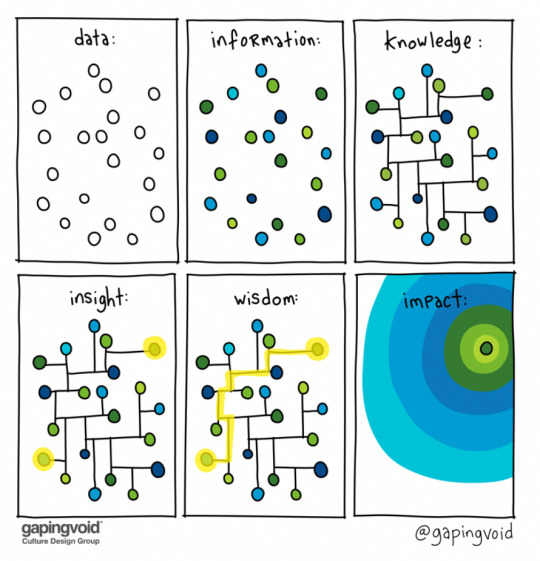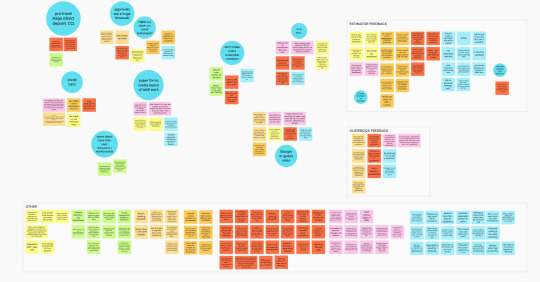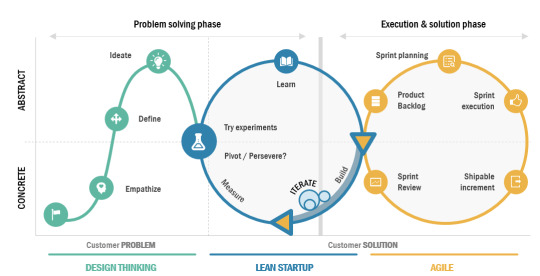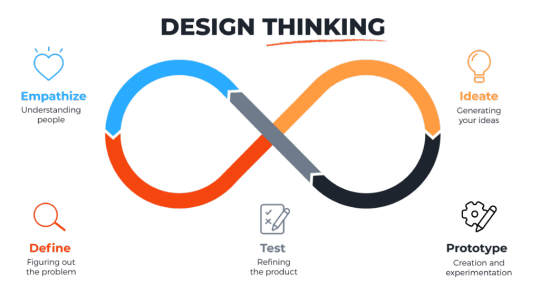#user-centereddesign
Explore tagged Tumblr posts
Link
#all-electrictraveltrailer#California#CES2025#electricRV#Fremont#Futurride#Nvidia#NvidiaDriveOrin#Pebble#PebbleFlow#sustainablemobility#user-centereddesign
0 notes
Text
Week 23: Visualizing Information
Nov 25 - 29, 2019
As Maddy mentioned, over the past couple weeks we’ve had a half-dozen interviews with public servants, so this week we took the time to regroup and look for patterns and opportunities.

Image credit: @gapingvoid-blog
As we talked with travellers and travel arrangers, we dug into their current processes and tools, and also gave the opportunity to offer feedback on some conceptual prototypes we’re working on.
We have been working on a current-state service blueprint for the travel experience. While we know the overall steps to the processes of creating a travel request, booking and expensing travel, we are finding that we’re uncovering different tools and workflows as we talk with more people.
This is rewarding and drives home the value of ‘getting outside the building’ to look beyond what we think people are or should be doing, to observing what they’re really doing. Practically every travel arranger we spoke with could point us to their own departmental training or reference materials. In some cases, this was because they had specific departmental needs, but in many cases it was because they couldn’t find or weren’t aware of any official materials, so they made their own.
Designing a service is much, much more than putting a product in place and telling people to use it.
We gathered a lot of information from these interviews, and the product team gathered for a “What did we learn this week” synthesis session on Tuesday.
We identified topics that popped up across interviews, focusing primarily on areas that made the process time-consuming or error-prone. We used a unique sticky note colour for each interview so we could tell when issues applied to multiple participants, rather than just having one person who talked at length about an issue.

In case you’re wondering, yes we initially did this with hand-written sticky notes, though we brought them into MURAL so we could keep a digital copy to refer back to later.
On Wednesday, we did another team exercise - this time including more of the broader NextGEN Travel team. In this case, it was a design critique-style meeting where I had prepared three different samples of ways to communicate the current-state service blueprint, and the team asked questions and offered feedback.

Mojgan, Maddy and George write questions and comments on sticky notes and post them next to three different displays of information.
This session gave us the chance to talk through questions about the level of fidelity and detail of the blueprint. One was better at showing the magnitude of systems and touchpoints at a given stage, and the other was better at showing foreground/background and time aspects of the service.
One of the participants said that he preferred the more content-rich design, and it took him seeing the other versions to understand why it appealed to him. Having multiple options to look at raised questions, and ultimately we decided to incorporate elements from several of the blueprints.
I realized afterwards that I had unintentionally used three different tools to create them: one each using mural, figma and whimsical. They each had their own strengths in helping me create the visualizations.

After a lot of synthesis, we were eager to get to work! Maddy and Mike met and created a prioritized backlog to continue to work on our estimator prototype, based on what we’d heard from our early testers.
Maddy has also been flexing her “stakeholder management/relationship” skills as our product manager, meeting with representatives from other departments to formalize working more closely as we continue to iterate on product ideas. As anyone who does UX Research knows, recruitment is a major painpoint, so having a group from a department commit to working with us will be a huge help as we roll into the last few months of our fellowship.
Coming up with this blueprint is interesting, to see the current state, but we want to actually design solutions that can make a real difference in improving the experience. The best way for us to do that is to actually try something, to identify the strengths and weaknesses, and then try again. This is what will allow us to have confidence in what we present: that we’ve worked with users to understand their barriers, and received feedback in the solution we’re proposing.
Andrea UX Fellow
3 notes
·
View notes
Text
Hybrid Approach to Innovation

Combining Design Thinking, Lean Startup, and Agile Development The use of a hybrid of lean startup and agile software development can help organizations create innovative products and services in a flexible and iterative way. By combining the principles of lean startup, which emphasizes experimentation and learning from failure, with the principles of agile development, which emphasizes flexibility and adaptability, organizations can create a process that is responsive to change and continuously improving. This hybrid approach can be particularly useful for organizations that are looking to quickly build and iterate on new products or services, and to validate assumptions about customer needs and behaviors. By using agile development techniques to rapidly build and deliver functional prototypes, and by using lean startup principles to gather data and feedback from real users, organizations can create innovative solutions that are tailored to the needs of their customers. The use of a hybrid of lean startup and agile software development can help organizations create value for their customers, reduce risk and uncertainty, and drive continuous improvement in their development processes.

What is Design Thinking? Design thinking is a problem-solving approach that combines creative and analytical thinking in order to design innovative solutions to complex problems. It is often used in the fields of product design, user experience design, and service design, but can be applied to a wide range of fields and industries. The design thinking process typically involves the following steps: - Empathize: This step involves understanding and empathizing with the needs and challenges of the people for whom you are designing a solution. It may involve conducting research, such as interviews and observations, to gain insights into their perspectives and experiences. - Define: In this step, you define the problem you are trying to solve and develop a clear and concise statement that captures the essence of the challenge. - Ideate: This step involves generating a wide range of ideas for potential solutions to the problem. It is important to be creative and open-minded during this phase, and to encourage the generation of many diverse ideas. - Prototype: In this step, you create a tangible representation of your ideas in order to test and iterate on them. Prototyping can involve creating physical models, digital simulations, or other types of representations. - Test: This step involves testing your prototypes with real users or customers in order to gather feedback and learn what works and what doesn't. This feedback can be used to iterate on your prototypes and improve the final solution. Design thinking is often used in conjunction with agile development methodologies, which focus on rapid iteration and continuous improvement. It is a user-centered approach that helps designers create solutions that are tailored to the needs and desires of the people they are designing for.

What is Lean Startup? Lean startup is a business strategy that focuses on quickly building and iterating on a product or service in order to learn what works and what doesn't, and to validate assumptions about customer needs and behaviors. It emphasizes the importance of experimentation, learning from failure, and making data-driven decisions. The lean startup approach is based on the idea that traditional business planning methods are too slow and inflexible to be effective in today's rapidly changing business environment. Instead of spending a lot of time and resources on detailed business plans, lean startup proponents advocate for a more iterative and flexible approach that allows businesses to quickly test and validate their assumptions about their customers and market. The lean startup process typically involves the following steps: - Define a hypothesis: This step involves identifying a key assumption or hypothesis about your product or business model that you want to test. - Build a minimum viable product (MVP): This step involves creating a simplified version of your product or service that allows you to test your hypothesis with real customers or users. - Test your MVP: In this step, you gather data on how your MVP is received by real customers or users in order to validate or invalidate your hypothesis. - Analyze the results: This step involves analyzing the data you gathered from testing your MVP in order to learn what works and what doesn't. - Iterate: Based on the results of your analysis, you can then iterate on your product or business model in order to improve it and better meet the needs of your customers. The goal of the lean startup approach is to minimize the risk and uncertainty associated with launching a new product or business, and to increase the chances of success by quickly learning what works and what doesn't.

What is Agile? Agile is a project management approach that focuses on delivering high-quality software through iterative development and continuous collaboration between cross-functional teams. It emphasizes flexibility and adaptability, and encourages teams to respond to change and continuously improve their processes. The agile approach is based on the idea that traditional, Waterfall-style project management methods are too rigid and inflexible to be effective in today's rapidly changing business environment. Instead of trying to plan and execute a project in a linear, step-by-step fashion, agile proponents advocate for a more flexible and iterative approach that allows teams to respond to change and continuously improve their work. The agile process typically involves the following steps: - Define the project scope: This step involves identifying the goals, deliverables, and stakeholders for the project. - Break the project into smaller, manageable pieces: This step involves dividing the project into smaller, more manageable chunks called "sprints." Each sprint is a self-contained unit of work that can be completed in a short period of time (e.g. 1-4 weeks). - Prioritize and schedule work: In this step, the team prioritizes the work that needs to be done in each sprint, and creates a schedule for completing it. - Continuous iteration: During each sprint, the team works on completing the prioritized work, and regularly reviews and adjusts their plans based on feedback and new information. This process is repeated until the project is completed. The agile approach is designed to be flexible and adaptable, and encourages teams to continuously improve their processes and work together in a collaborative way. It is often used in conjunction with agile development methodologies such as Scrum and Kanban, which provide a structured framework for implementing agile principles. How is Design thinking and Lean startup used in problem solving? Design thinking and lean startup are both approaches to problem-solving that involve a combination of creative and analytical thinking, and a focus on delivering value to customers. Design thinking is a user-centered approach that involves empathizing with the needs and challenges of the people for whom you are designing a solution, defining the problem you are trying to solve, generating a wide range of ideas for potential solutions, prototyping and testing your ideas, and iterating on your prototypes based on feedback. The goal of design thinking is to create innovative solutions that are tailored to the needs and desires of the people you are designing for. Lean startup is a business strategy that focuses on quickly building and iterating on a product or service in order to learn what works and what doesn't, and to validate assumptions about customer needs and behaviors. It involves defining a hypothesis, creating a minimum viable product (MVP) to test the hypothesis, gathering data on how the MVP is received by real customers or users, analyzing the results, and iterating on the product or business model based on the results. The goal of lean startup is to minimize the risk and uncertainty associated with launching a new product or business, and to increase the chances of success by quickly learning what works and what doesn't. Both design thinking and lean startup can be useful approaches to problem-solving in a variety of contexts, and may be used individually or in combination with other methods. They are both designed to be flexible and adaptable, and encourage a focus on experimentation, iteration, and continuous learning in order to create innovative and valuable solutions. How is agile used in execution and solution phase? Agile is a project management approach that is often used in the execution and solution phase of a project in order to deliver high-quality software or other solutions in a flexible and iterative way. During the execution and solution phase of a project, agile teams focus on delivering small, manageable chunks of work called "sprints." Each sprint is a self-contained unit of work that can be completed in a short period of time (e.g. 1-4 weeks), and typically involves completing a set of prioritized tasks or deliverables. In order to deliver the work in each sprint, agile teams typically follow a set of iterative and incremental development principles, including: - Continuous collaboration: Agile teams place a strong emphasis on collaboration and communication, and work together in a cross-functional way to deliver the work in each sprint. - Continuous integration and delivery: Agile teams aim to continuously integrate and deliver their work in small increments, rather than waiting until the end of the project to deliver a large, finished product. - Continuous testing and feedback: Agile teams focus on testing their work and gathering feedback from stakeholders throughout the development process, and use this feedback to iterate on their solutions and improve the final product. By following these principles, agile teams are able to deliver high-quality solutions in a flexible and adaptable way that is responsive to change and continuously improving. Agile methodologies such as Scrum and Kanban provide a structured framework for implementing agile principles in a project. Conclusion In conclusion, the hybrid approach is a powerful tool for organizations that are looking to create value for their customers and drive innovation in a rapidly changing business environment. By combining the principles of design thinking, which emphasizes empathy and user-centered design, with the principles of lean startup, which emphasizes experimentation and learning from failure, and the principles of agile development, which emphasizes flexibility and adaptability, organizations can create a flexible, iterative, and data-driven process that is focused on delivering value to customers. Whether you are looking to use the hybrid approach in your own organization or project, or you are simply interested in learning more about these powerful tools and techniques, this guide has something for you. By following the principles and practices outlined in this guide, you can start using the hybrid approach in your own work, and drive innovation and continuous improvement in your organization. Read the full article
#collaboration#empathy#flexibility#innovation#iteration#problem-solving#prototyping#testing#user-centereddesign
0 notes
Photo



| TONY'S CHOCOLONELY SMAAKMAKER |
chocolicious brand awareness for a fairtrade business
The Smaakmaker informs people about the raison d’être of Tony’s Chocolonely: Its unique cooperation with cocoa farmers in Ghana and Ivorty Coast. Being in a cafe, people can order the Smaakmaker from the menu as a new, two-person treat. Users can decorate chocolate nibs with ‘crazy’ flavour combinations, meanwhile looking at the witty, informative postcards. The chocolates are attached to the postcards so that people will be invited to read these.
The cheerful product works contagious for other consumers in the cafe. It invites people to share Tony’s story with friends and family via personal social media, by sending the postcards or by word of mouth. For Tony’s the product is a platform via which they can communicate to their consumers. Postcards being the ‘software’ of the Smaakmaker, they can easily be adjusted or updated, thereby keeping returning clients satisfied.
0 notes
Text
https://uxdesign.cc/how-privilege-impacts-empathy-b34ad0c16431
"An empathetic service would ground itself in the concrete needs of concrete people. It’s not about innovation, big data, government-as-a-platform, transparency, crowd-funding, open data, or civic tech. It’s about people. Learning toprioritize people and their needs will be a long slog. It’s the kind of change that happens slowly, one person at a time. But we should start.” — Jake Solomon
0 notes